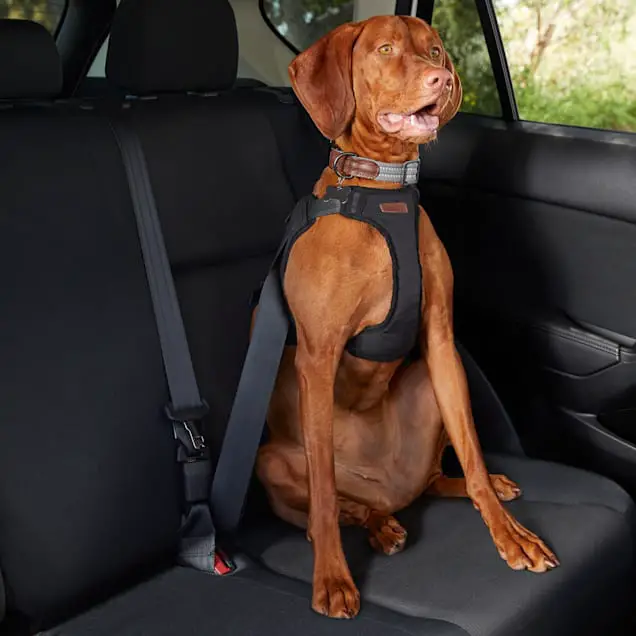Reddy Dog Harness Instructions Manual

IMPORTANT: Please be sure to read and understand all instructions before using the Reddy dog harness on your dog.
Failure to follow each instruction can result in serious injury or death to your dog. Keep instructions and review them before attempting new walking positions.
Thank you for buying the Reddy Dog Harness.
You can follow the steps below, or watch a video demonstration with instructions on how to put the Reddy Dog Harness on your dog.
The Reddy Dog Harness is designed to gently discourage your dog from pulling while walking on a leash. It’s so simple – easy to fit and easy to use. There is very little acclimation time or special technique required.
Unlike traditional harnesses, the Reddy Dog Harness never causes coughing, gagging or choking because the chest strap rests low across the breastbone, not on the delicate tracheal area.
Traditional harnesses actually encourage dogs to pull harder because of the “opposition reflex.” That’s the reflex that causes sled dogs to pull against pressure.
The Reddy Dog Harness’ unique front-chest leash attachment stops pulling by steering your dog to the side and redirecting his attention towards you. And, its martingale loop provides extra leverage for easy, relaxed control.
Features of the Reddy Dog Harness
• We included a quick-snap buckle on both the shoulder and belly straps to make it easier to get the
harness on and off your dog.
• Soft-but-strong nylon and 4 adjustment points provide maximum comfort and a reliable fit.
• The martingale loop on the chest strap tightens when your dog pulls, preventing
slack in the harness and giving you greater control.
• The complementary color of the belly strap makes it easier to identify
each strap, while keeping the overall look pleasantly color-coordinated. You can quickly see which strap goes over the shoulders, and
which goes under the belly.
How To Fit The Reddy Dog Harness
Before you get started, here are some helpful tips!
• Identify the straps of your harness –
see Fig. 1 and Fig. 2.
• Start with all straps
fully extended
Step 1: Fit the shoulder strap
Place the shoulder strap over the dog’s head with the
chest strap
resting on the dog’s chest, and
connect buckle.
• Adjust the shoulder strap so the
connector rings sit above and behind
the dog’s shoulder
Step 2: Fit the belly strap
- Connect the belly strap to the quick-snap buckle.
- Tighten the belly strap to a comfortably snug fit. Once
- the shoulder and belly straps have been connected and
- adjusted they should:
- Resemble a vertical line as much as possible and not
- be in the dog’s sensitive armpit area.
- Have a snug fit – so snug that
- you should only be able to fit
- one finger between the nylon
- strap and the dog’s fur
- (or two fingers for larger dogs). A
- snug fit is important because the
- shoulder and belly straps combined
- create the foundation that keeps the harness in place,
- keeping the straps from moving against the dog’s fur.
Step 3: Fit the chest strap
- Gently press your fingers on the lower front of your dog’s chest to locate the breastbone.
When adjusted correctly, the chest strap will be horizontal, resting over the dog’s breastbone. - The strap should fit more loosely than the belly and shoulder straps, but should not hang down, gap or ride up on your dog. If this happens, you may need a different size (see Troubleshooting).
- Adjust each portion of the chest strap equally to keep the D-ring centered.Attach the leash to the D-ring on the strap, and go for a walk!
Reddy Step-in Dog Harness Fitting Tips
• You may need to remove the harness during fitting
to make adjustments.
• Dogs may “tense up” during fitting, so check the fit
again after the dog has walked in the harness for a
few minutes. Readjust if needed.
• Using a leash with a heavy clasp may cause the
chest strap to sag. Please choose a 4 to 6 foot leash
with a light but sturdy clasp.
• It is not recommended to use a flex lead with the
harness, as the constant tension will cause the chest
strap to loosen on its own, and possibly encourage
the dog to pull.
• Couplers are also not recommended for use with the
harness – pulling from the second dog could cause
tension on the non-pulling dog, confusing him and
inhibiting training.
Reddy Step-in Dog Harness Washing Instructions
This is a step-by-step guide to washing your Reddy Step-in Dog Harness.
1) Fill a tub or sink with lukewarm water.
2) Add a small amount of detergent and mix with water.
3) Submerge the harness in the soapy water and scrub it with your washing brush to remove dirt, grime, and stains.
4) Rinse the harness under running water until all of the soap is gone from it.
5) Hang it up to dry in a well-ventilated area or lay it flat on top of a towel on top of an airy surface (e.g., drying rack).
Training and usage tips
Although the harness may have an immediate impact on your dog’s pulling habits, and it may feel
more manageable to walk your dog, he still may pull while wearing it.
The harness is designed to redirect your dog from pulling and help achieve a loose leash walk – if your dog pulls excessively, even while wearing the harness, you may want to try our Reddy Dog collar.
Use The Leash Tension To Guide Your Dog
As soon as you feel tension on the leash, gently redirect your dog’s attention to you (you may need to slow down or stop). Once he is back in the desired heeling position, we suggest rewarding him with a treat* before you start walking again.
You may find yourself redirecting your dog quite a bit in the beginning, but with patience, consistency, and rewards like his favorite treat, he will quickly learn.
Reddy Comfort Dog Harness Size Chart
The Reddy Comfort Dog Harness Size Chart is a tool to help you find the right size for your dog. It includes all the measurements of the harness and their corresponding sizes.
This chart is useful for anyone looking to buy a new dog harness, or just wanting to know which size would be best for their pup.
| Size | Chest Girth Measure around chest, behind front leg | Neck Measure around neck | Breed The type of Dog |
| XXS | 9-12 in, 22.9-30.5cm | 8-12 in, 20.3-30.5cm | Chihuahua, Toy poodle |
| XS | 12-14 in, 30.5-35.6cm | 9-15 in, 22.9-38.1 cm | Maltese, Pomeranian, Yorkie |
| S | 14-17 in, 35.6-43.2cm | 11-16 in, 27.9-40.6 cm | Jack Russell, Pekingese, Pug |
| M | 18-21 in, 45.7-53.3cm | 13-17 in, 33-43.2 cm | Beagle, Cocker Spaniel, French BullDog, West Highland Terrier |
| L | 20-25 in, 50.8-63.5cm | 16-20 in, 40.6-50.8cm | Australian Cattle Dog, Schnauzer |
| XL | 25-30 in, 63.5-76.2cm | 18-24 in, 45.7-61 cm | Airedale, Boxer, Collie, Pitbull |
| XXL | 30-34 in, 76.2-86.4cm | 20-26 in, 50.8-66 cm | Doberman, German Shepherd, Golden Retriever, Greyhound, Husky, Labrador |
| XXXL | 33-38 in, 83.8-96.5cm | 24-32 in, 61-81.3 cm | Bull Mastiff, Great Dane, Irish Wolfhound, Saint Bernard |
Troubleshooting
If the chest strap is slipping while on your dog, or if he
is experiencing chafing or rubbing in the armpit area, we
recommend:
• Reviewing the fitting instructions. It is very important
to have a snug fit in the girth – loose straps can cause
the chest strap to slip, and can also cause chafing.
Think about a shoe slipping off your heel – over time
that movement against your foot will cause your heel
to chafe.
• Reviewing the training techniques. Excessive pulling
can cause the chest strap to slip and can also cause
chafing.
Having trouble finding the perfect fit? Here are a few tips
that may help.
First, we suggest taking a look at your dog from the
side. While the dog is standing, how does the harness
look – like a sideways “T” or a “Y” ?
Sideways T
When fit properly, the harness should resemble a sideways T, as much as possible.
If the harness look like a T and the chest strap has room for adjustment (can be
adjusted larger or smaller), the harness is most likely the correct size for your dog.
Sideways Y
If the harness looks like a sideways Y and the chest strap has room for adjustment, the harness is most likely the right size, but not yet fit correctly. However, if the harness looks like a sideways Y and the chest strap is extended to its fullest length, the harness is most likely too small, and a larger size is needed. Please refer to our sizing chart to find the best size harness for your dog.
We guarantee the materials and workmanship of the Reddy Dog Harness, but we can’t keep your dog from chewing it! Please be sure to supervise your dog while he wears the Reddy Dog Harness and store it safely when not in use. If your dog does chew the Reddy Dog Harness, we will happily replace it for a small fee.
